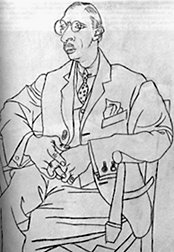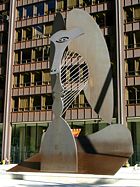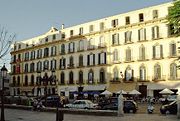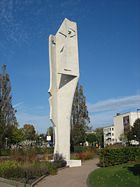Pablo Picasso
2008/9 Schools Wikipedia Selection. Related subjects: Artists
| Pablo Picasso | |
 Pablo Picasso 1962 |
|
| Birth name | Pablo Diego José Francisco de Paula Juan Nepomuceno María de los Remedios Cipriano de la Santísima Trinidad Martyr Patricio Clito Ruiz y Picasso |
| Born | October 25, 1881 Málaga, Spain |
| Died | April 8, 1973 (aged 91) Mougins, France |
| Nationality | Spanish |
| Field | Painting, Drawing, Sculpture, Printmaking, Ceramics |
| Training | Jose Ruíz (father), Academy of Arts, Madrid |
| Movement | Cubism |
Pablo Diego José Francisco de Paula Juan Nepomuceno María de los Remedios Cipriano de la Santísima Trinidad Martyr Patricio Clito Ruiz y Picasso ( October 25, 1881 – April 8, 1973) was a Spanish painter, draughtsman, and sculptor. As one of the most recognized figures in twentieth-century art, he is best known for co-founding the Cubist movement and for the wide variety of styles embodied in his work. Among his most famous works are the proto-Cubist Les Demoiselles d'Avignon (1907) and his depiction of the German bombing of Guernica during the Spanish Civil War, Guernica (1937).
Biography
Picasso was baptized Pablo Diego José Francisco de Paula Juan Nepomuceno María de los Remedios Cipriano de la Santísima Trinidad Clito, a series of names honouring various saints and relatives. Added to these were Ruiz and Picasso, for his father and mother, respectively, as per Spanish custom. Born in the city of Málaga in the Andalusian region of Spain, he was the first child of Don José Ruiz y Blasco (1838–1913) and María Picasso y López. Picasso’s family was middle-class; his father was also a painter who specialized in naturalistic depictions of birds and other game. For most of his life Ruiz was a professor of art at the School of Crafts and a curator of a local museum. Ruiz’s ancestors were minor aristocrats.
The young Picasso showed a passion and a skill for drawing from an early age; according to his mother, his first words were “piz, piz”, a shortening of lápiz, the Spanish word for ‘pencil’. From the age of seven, Picasso received formal artistic training from his father in figure drawing and oil painting. Ruiz was a traditional, academic artist and instructor who believed that proper training required disciplined copying of the masters, and drawing the human body from plaster casts and live models. His son became preoccupied with art to the detriment of his classwork.
The family moved to La Coruña in 1891 so his father could become a professor at the School of Fine Arts. They stayed almost four years. On one occasion the father found his son painting over his unfinished sketch of a pigeon. Observing the precision of his son’s technique, Ruiz felt that the thirteen-year-old Picasso had surpassed him, and vowed to give up painting.
In 1895, Picasso's seven-year old sister, Conchita, died of diphtheria - a traumatic event in his life.After her death, the family moved to Barcelona, with Ruiz transferring to its School of Fine Arts. Picasso thrived in the city, regarding it in times of sadness or nostalgia as his true home. Ruiz persuaded the officials at the academy to allow his son to take an entrance exam for the advanced class. This process often took students a month, but Picasso completed it in a week, and the impressed jury admitted Picasso, who was still 13. The student lacked discipline but made friendships that would affect him in later life. His father rented him a small room close to home so Picasso could work alone, yet Ruiz checked up on him numerous times a day, judging his son’s drawings. The two argued frequently.
Picasso’s father and uncle decided to send the young artist to Madrid’s Royal Academy of San Fernando, the foremost art school in the country. In 1897, Picasso, age 16, set off for the first time on his own. Yet his difficulties accepting formal instruction led him to stop attending class soon after enrollment. Madrid, however, held many other attractions: the Prado housed paintings by the venerable Diego Velázquez, Francisco Goya, and Francisco Zurbarán. Picasso especially admired the works of El Greco; their elements, like elongated limbs, arresting colors, and mystical visages, are echoed in Picasso’s œuvre.
Personal life
After studying art in Madrid, Picasso made his first trip to Paris in 1900, then the art capital of Europe. There, he met his first Parisian friend, the journalist and poet Max Jacob, who helped Picasso learn the language and its literature. Soon they shared an apartment; Max slept at night while Picasso slept during the day and worked at night. These were times of severe poverty, cold, and desperation. Much of his work had to be burned to keep the small room warm. In Madrid in 1901, Picasso and his anarchist friend Francisco de Asís Soler founded the magazine Arte Joven (Young Art), which published five issues. Soler solicited articles and Picasso illustrated the journal, mostly contributing grim cartoons depicting and sympathizing with the state of the poor. From that day, he started to sign his work simply Picasso, while before he had signed Pablo Ruiz y Picasso.
In the early twentieth century, Picasso divided his time between Barcelona and Paris. In 1904, in the middle of a storm, he met Fernande Olivier, a Bohemian artist who became his mistress. Olivier appears in many of his Rose period paintings. After acquiring fame and some fortune, Picasso left Olivier for Marcelle Humbert, whom he called Eva. Picasso included declarations of his love for Eva in many Cubist works.
In Paris, Picasso entertained a distinguished coterie of friends in the Montmartre and Montparnasse quarters, including André Breton, poet Guillaume Apollinaire, writer Alfred Jarry, and Gertrude Stein. Apollinaire was arrested on suspicion of stealing the Mona Lisa from the Louvre in 1911. Apollonaire pointed to his friend Picasso, who was also brought in for questioning, but both were later exonerated.

He maintained a number of mistresses in addition to his wife or primary partner. Picasso was married twice and had four children by three women. In the summer of 1918, Picasso married Olga Khokhlova, a ballerina with Sergei Diaghilev’s troupe, for whom Picasso was designing a ballet, Parade, in Rome; and they spent their honeymoon in the villa near Biarritz of the glamorous Chilean art patron Eugenia Errázuriz. Khokhlova introduced Picasso to high society, formal dinner parties, and all the social niceties attendant on the life of the rich in 1920s Paris. The two had a son, Paulo, who would grow up to be a dissolute motorcycle racer and chauffeur to his father. Khokhlova’s insistence on social propriety clashed with Picasso’s bohemian tendencies and the two lived in a state of constant conflict. During the same period that Picasso collaborated with Diaghilev’s troup, he and Igor Stravinsky collaborated on Pulcinella in 1920. Picasso took the opportunity to make several sketches of the composer. In 1927 Picasso met 17 year old Marie-Thérèse Walter and began a secret affair with her. Picasso’s marriage to Khokhlova soon ended in separation rather than divorce, as French law required an even division of property in the case of divorce, and Picasso did not want Khokhlova to have half his wealth. The two remained legally married until Khokhlova’s death in 1955. Picasso carried on a long-standing affair with Marie-Thérèse Walter and fathered a daughter, Maia, with her. Marie-Thérèse lived in the vain hope that Picasso would one day marry her, and hanged herself four years after Picasso’s death.
The photographer and painter Dora Maar was also a constant companion and lover of Picasso. The two were closest in the late 1930s and early 1940s and it was Maar who documented the painting of Guernica.
During the Second World War, Picasso remained in Paris while the Germans occupied the city. Picasso’s artistic style did not fit the Nazi views of art, so he was not able to show his works during this time. Retreating to his studio, he continued to paint all the while. Although the Germans outlawed bronze casting in Paris, Picasso continued regardless, using bronze smuggled to him by the French resistance.
After the liberation of Paris in 1944, Picasso began to keep company with a young art student, Françoise Gilot. The two eventually became lovers, and had two children together, Claude and Paloma. Unique among Picasso’s women, Gilot left Picasso in 1953, allegedly because of abusive treatment and infidelities. This came as a severe blow to Picasso.
He went through a difficult period after Gilot’s departure, coming to terms with his advancing age and his perception that, now in his 70s, he was no longer attractive, but rather grotesque to young women. A number of ink drawings from this period explore this theme of the hideous old dwarf as buffoonish counterpoint to the beautiful young girl, including several from a six-week affair with Geneviève Laporte, who in June 2005 auctioned off the drawings Picasso made of her.
Picasso was not long in finding another lover, Jacqueline Roque. She worked at the Madoura Pottery in Vallauris on the French Riviera, where Picasso made and painted ceramics. The two remained together for the rest of Picasso’s life, marrying in 1961. Their marriage was also the means of one last act of revenge against Gilot. Gilot had been seeking a legal means to legitimize her children with Picasso, Claude and Paloma. With Picasso’s encouragement, she had arranged to divorce her then husband, Luc Simon, and marry Picasso to secure her children’s rights. Picasso then secretly married Roque after Gilot had filed for divorce in order to exact his revenge for her leaving him.
Picasso had constructed a huge gothic structure and could afford large villas in the south of France, at Notre-dame-de-vie on the outskirts of Mougins, in the Provence-Alpes-Côte d'Azur. By this time he was a celebrity, and there was often as much interest in his personal life as his art.
In addition to his manifold artistic accomplishments, Picasso had a film career, including a cameo appearance in Jean Cocteau’s Testament of Orpheus. Picasso always played himself in his film appearances. In 1955 he helped make the film Le Mystère Picasso (The Mystery of Picasso) directed by Henri-Georges Clouzot.
Pablo Picasso died on April 8, 1973 in Mougins, France, while he and his wife Jacqueline entertained friends for dinner. His final words were “Drink to me, drink to my health, you know I can’t drink any more.” He was interred at Castle Vauvenargues’ park, in Vauvenargues, Bouches-du-Rhône. Jacqueline Roque prevented his children Claude and Paloma from attending the funeral.
Political views
Picasso remained neutral during World War I, the Spanish Civil War, and World War II, refusing to fight for any side or country. Some of his contemporaries felt that his pacifism had more to do with cowardice than principle. An article in the New Yorker called him “a coward, who sat out two world wars while his friends were suffering and dying”. As a Spanish citizen living in France, Picasso was under no compulsion to fight against the invading Germans in either World War. In the Spanish Civil War, service for Spaniards living abroad was optional and would have involved a voluntary return to the country to join either side. While Picasso expressed anger and condemnation of Francisco Franco and fascists through his art, he did not take up arms against them. He also remained aloof from the Catalan independence movement during his youth despite expressing general support and being friendly with activists within it.
In 1944 Picasso joined the French Communist Party, attended an international peace conference in Poland, and in 1950 received the Stalin Peace Prize from the Soviet government. But party criticism of a portrait of Stalin as insufficiently realistic cooled Picasso’s interest in communist politics, though he remained a loyal member of the Communist Party until his death. In a 1945 interview with Jerome Seckler, Picasso stated: “I am a Communist and my painting is Communist painting. … But if I were a shoemaker, Royalist or Communist or anything else, I would not necessarily hammer my shoes in a special way to show my politics.” He was against the intervention of the United Nations and the United States in the Korean civil war and he depicted it in Massacre in Korea. In 1962, he received the International Lenin Peace Prize.
Art
Picasso’s work is often categorized into periods. While the names of many of his later periods are debated, the most commonly accepted periods in his work are the Blue Period (1901–1904), the Rose Period (1905–1907), the African-influenced Period (1908–1909), Analytic Cubism (1909–1912), and Synthetic Cubism (1912–1919).
In 1939–40 the Museum of Modern Art in New York City, under its director Alfred Barr, a Picasso enthusiast, held a major and highly successful retrospective of his principal works up until that time. This exhibition lionized the artist, brought into full public view in America the scope of his artistry, and resulted in a reinterpretation of his work by contemporary art historians and scholars.
Before 1901
Picasso’s training under his father began before 1890. His progress can be traced in the collection of early works now held by the Museu Picasso in Barcelona, which provides one of the most comprehensive records extant of any major artist’s beginnings. During 1893 the juvenile quality of his earliest work falls away, and by 1894 his career as a painter can be said to have begun. The academic realism apparent in the works of the mid-1890s is well displayed in The First Communion (1896), a large composition that depicts his sister, Lola. In the same year, at the age of 14, he painted Portrait of Aunt Pepa, a vigorous and dramatic portrait that Juan-Eduardo Cirlot has called “without a doubt one of the greatest in the whole history of Spanish painting.”
In 1897 his realism became tinged with Symbolist influence, in a series of landscape paintings rendered in non naturalistic violet and green tones. What some call his Modernist period (1899–1900) followed. His exposure to the work of Rossetti, Steinlen, Toulouse-Lautrec and Edvard Munch, combined with his admiration for favorite old masters such as El Greco, led Picasso to a personal version of modernism in his works of this period.
Blue Period
Picasso’s Blue Period (1901–1904) consists of somber paintings rendered in shades of blue and blue-green, only occasionally warmed by other colors. This period’s starting point is uncertain; it may have begun in Spain in the spring of 1901, or in Paris in the second half of the year. Many paintings of gaunt mothers with children date from this period. In his austere use of colour and sometimes doleful subject matter— prostitutes and beggars are frequent subjects—Picasso was influenced by a trip through Spain and by the suicide of his friend Carlos Casagemas. Starting in autumn of 1901 he painted several posthumous portraits of Casagemas, culminating in the gloomy allegorical painting La Vie (1903), now in the Cleveland Museum of Art.
The same mood pervades the well-known etching The Frugal Repast (1904), which depicts a blind man and a sighted woman, both emaciated, seated at a nearly bare table. Blindness is a recurrent theme in Picasso’s works of this period, also represented in The Blindman’s Meal (1903, the Metropolitan Museum of Art) and in the portrait of Celestina (1903). Other works include Portrait of Soler and Portrait of Suzanne Bloch.
Rose Period
The Rose Period (1904–1906) is characterized by a more cheery style with orange and pink colors, and featuring many acrobats and harlequins. The harlequin, a comedic character usually depicted in checkered patterned clothing, became a personal symbol for Picasso. Picasso met Fernande Olivier, a model for sculptors and artists, in Paris in 1904, and many of these paintings are influenced by his warm relationship with her, in addition to his increased exposure to French painting. The generally upbeat and optimistic mood of paintings in this period is reminiscent of the 1899–1901 period (i.e. just prior to the Blue Period) and 1904 can be considered a transition year between the two periods.
African-influenced Period
Picasso’s African-influenced Period (1907–1909) begins with the two figures on the right in his painting, Les Demoiselles d'Avignon, which were inspired by African artifacts. Formal ideas developed during this period lead directly into the Cubist period that follows.
Cubism
Analytic cubism (1909–1912) is a style of painting Picasso developed along with Georges Braque using monochrome brownish and neutral colours. Both artists took apart objects and “analyzed” them in terms of their shapes. Picasso and Braque’s paintings at this time have many similarities. Synthetic cubism (1912–1919) was a further development of the genre, in which cut paper fragments—often wallpaper or portions of newspaper pages—were pasted into compositions, marking the first use of collage in fine art.
Classicism and surrealism
In the period following the upheaval of World War I, Picasso produced work in a neoclassical style. This “return to order” is evident in the work of many European artists in the 1920s, including André Derain, Giorgio de Chirico, and the artists of the New Objectivity movement. Picasso’s paintings and drawings from this period frequently recall the work of Ingres.
During the 1930s, the minotaur replaced the harlequin as a common motif in his work. His use of the minotaur came partly from his contact with the surrealists, who often used it as their symbol, and it appears in Picasso’s Guernica.
Arguably Picasso’s most famous work is his depiction of the German bombing of Guernica during the Spanish Civil War — Guernica. This large canvas embodies for many the inhumanity, brutality and hopelessness of war. Asked to explain its symbolism, Picasso said, “It isn’t up to the painter to define the symbols. Otherwise it would be better if he wrote them out in so many words! The public who look at the picture must interpret the symbols as they understand them.”
Guernica hung in New York’s Museum of Modern Art for many years. In 1981 Guernica was returned to Spain and exhibited at the Casón del Buen Retiro. In 1992 the painting hung in Madrid’s Reina Sofía Museum when it opened.
Later works

Picasso was one of 250 sculptors who exhibited in the 3rd Sculpture International held at the Philadelphia Museum of Art in the summer of 1949. In the 1950s, Picasso’s style changed once again, as he took to producing reinterpretations of the art of the great masters. He made a series of works based on Velazquez’s painting of Las Meninas. He also based paintings on works by Goya, Poussin, Manet, Courbet and Delacroix.
He was commissioned to make a maquette for a huge 50-foot (15 m)-high public sculpture to be built in Chicago, known usually as the Chicago Picasso. He approached the project with a great deal of enthusiasm, designing a sculpture which was ambiguous and somewhat controversial. What the figure represents is not known; it could be a bird, a horse, a woman or a totally abstract shape. The sculpture, one of the most recognizable landmarks in downtown Chicago, was unveiled in 1967. Picasso refused to be paid $100,000 for it, donating it to the people of the city.
Picasso’s final works were a mixture of styles, his means of expression in constant flux until the end of his life. Devoting his full energies to his work, Picasso became more daring, his works more colourful and expressive, and from 1968 through 1971 he produced a torrent of paintings and hundreds of copperplate etchings. At the time these works were dismissed by most as pornographic fantasies of an impotent old man or the slapdash works of an artist who was past his prime. Only later, after Picasso’s death, when the rest of the art world had moved on from abstract expressionism, did the critical community come to see that Picasso had already discovered neo-expressionism and was, as so often before, ahead of his time.
Commemoration and legacy
At the time of his death many of his paintings were in his possession, as he had kept off the art market what he didn’t need to sell. In addition, Picasso had a considerable collection of the work of other famous artists, some his contemporaries, such as Henri Matisse, with whom he had exchanged works. Since Picasso left no will, his death duties (estate tax) to the French state were paid in the form of his works and others from his collection. These works form the core of the immense and representative collection of the Musée Picasso in Paris. In 2003, relatives of Picasso inaugurated a museum dedicated to him in his birthplace, Málaga, Spain, the Museo Picasso Málaga.
The Museu Picasso in Barcelona features many of Picasso’s early works, created while he was living in Spain, including many rarely seen works which reveal Picasso’s firm grounding in classical techniques. The museum also holds many precise and detailed figure studies done in his youth under his father’s tutelage, as well as the extensive collection of Jaime Sabartés, Picasso’s close friend from his Barcelona days who, for many years, was Picasso’s personal secretary.
The film Surviving Picasso was made about Picasso in 1996, as seen through the eyes of Françoise Gilot. Anthony Hopkins played Picasso in the movie.
Value of paintings
Some paintings by Picasso rank among the most expensive paintings in the world.
- Nude on a black armchair sold for USD $45.1 million in 1999 to Les Wexner, who then donated it to the Wexner Centre for the Arts.
- Les Noces de Pierrette sold for more than USD $51 million in 1999.
- Garçon à la pipe sold for USD $104 million at Sotheby's on May 4, 2004, establishing a new price record.
- Dora Maar au Chat sold for USD $95.2 million at Sotheby’s on May 3, 2006.
As of 2004, Picasso remains the top ranked artist (based on sales of his works at auctions) according to the Art Market Trends report. (pdf)
Children
- Paulo ( February 4, 1921 – June 5, 1975) (Born Paul Joseph Picasso) — with Olga Khokhlova
- Maia ( September 5, 1935 – ) (Born Maria de la Concepcion Picasso) — with Marie-Thérèse Walter
- Claude ( May 15, 1947 –) (Born Claude Pierre Pablo Picasso) — with Françoise Gilot
- Paloma ( April 19, 1949 – ) (Born Anne Paloma Picasso) — with Françoise Gilot

